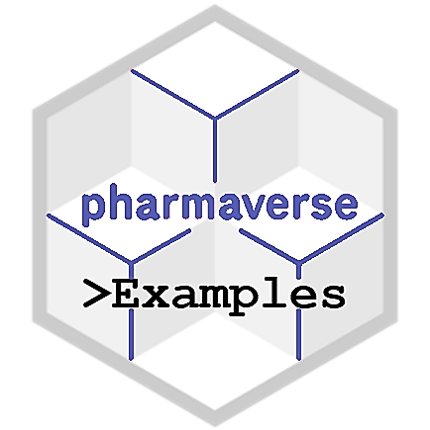---
title: "Documents"
order: 2
---
```{r setup script, include=FALSE, purl=FALSE}
invisible_hook_purl <- function(before, options, ...) {
knitr::hook_purl(before, options, ...)
NULL
}
knitr::knit_hooks$set(purl = invisible_hook_purl)
```
# Introduction
Below is a step-by-step guide demonstrating how to use `{rtables.officer}` for creating and exporting a clinical trial results table as a docx document.
# Setup and Data Preparation
Load the necessary libraries and prepare the dataset:
```{r}
library(tern)
library(dplyr)
library(rtables.officer)
# Load example datasets
adsl <- pharmaverseadam::adsl
adlb <- pharmaverseadam::adlb
# Convert character variables to factors and handle missing levels
adsl <- df_explicit_na(adsl)
adlb <- df_explicit_na(adlb)
# Create a temporary file for the output
tf <- tempfile(fileext = ".docx")
```
# Data Filtering
Filter the dataset for specific parameters and visits:
```{r}
adlb_f <- adlb %>%
dplyr::filter(
PARAM %in% c("Alanine Aminotransferase (U/L)", "Creatinine Kinase (U/L)") &
!(ACTARM == "B: Placebo" & AVISIT == "Week 2")
)
```
# Define Custom Analysis Function
Create a custom function to perform the analysis:
```{r}
afun <- function(x, .var, .spl_context, ...) {
n_fun <- sum(!is.na(x), na.rm = TRUE)
mean_sd_fun <- if (n_fun == 0) c(NA, NA) else c(mean(x, na.rm = TRUE), sd(x, na.rm = TRUE))
median_fun <- if (n_fun == 0) NA else median(x, na.rm = TRUE)
min_max_fun <- if (n_fun == 0) c(NA, NA) else c(min(x), max(x))
is_chg <- .var == "CHG"
is_baseline <- .spl_context$value[which(.spl_context$split == "AVISIT")] == "Baseline"
if (is_baseline && is_chg) n_fun <- mean_sd_fun <- median_fun <- min_max_fun <- NULL
in_rows(
"n" = n_fun,
"Mean (SD)" = mean_sd_fun,
"Median" = median_fun,
"Min - Max" = min_max_fun,
.formats = list("n" = "xx", "Mean (SD)" = "xx.xx (xx.xx)", "Median" = "xx.xx", "Min - Max" = "xx.xx - xx.xx"),
.format_na_strs = list("n" = "NE", "Mean (SD)" = "NE (NE)", "Median" = "NE", "Min - Max" = "NE - NE")
)
}
```
# Define Table Layout
Create the layout for the table:
```{r}
lyt <- basic_table() %>%
split_cols_by("ACTARM", show_colcounts = TRUE, split_fun = keep_split_levels(levels(adlb_f$ACTARM)[c(1, 2)])) %>%
split_rows_by("PARAM",
split_fun = drop_split_levels, label_pos = "topleft",
split_label = obj_label(adlb_f$PARAM), page_by = TRUE
) %>%
split_rows_by("AVISIT",
split_fun = drop_split_levels, label_pos = "topleft",
split_label = obj_label(adlb_f$AVISIT)
) %>%
split_cols_by_multivar(
vars = c("AVAL", "CHG"),
varlabels = c("Value at Visit", "Change from Baseline")
) %>%
analyze_colvars(afun = afun)
```
# Build and Display the Table
Build the table using the defined layout:
```{r}
result <- build_table(lyt, adlb_f)
result
```
Assign titles and footers:
```{r}
main_title(result) <- "Alanine Aminotransferase Measurement"
subtitles(result) <- c("This is a subtitle.", "This is another subtitle.")
main_footer(result) <- "This is a demo table for illustration purpose."
prov_footer(result) <- "Program: demo_poc_docx.R\nDate: 2024-11-06\nVersion: 0.0.1\n"
```
# Convert to `flextable` and Export to Word
Convert the table to a `flextable` object and export it to a Word document:
```{r}
flx_res <- tt_to_flextable(result)
export_as_docx(flx_res,
file = tf,
section_properties = section_properties_default(orientation = "landscape")
)
flx_res
```
## Advanced Customizations
You can further customize your tables, such as setting column widths, handling pagination, and more.
### Column Widths
```{r}
cw <- propose_column_widths(result)
cw <- cw / sum(cw)
cw <- c(0.6, 0.1, 0.1, 0.1, 0.1)
spd <- section_properties_default(orientation = "landscape")
fin_cw <- cw * spd$page_size$width / 2 / sum(cw)
flex_tbl <- tt_to_flextable(result,
total_page_width = spd$page_size$width / 2,
counts_in_newline = TRUE,
autofit_to_page = FALSE,
bold_titles = TRUE,
colwidths = cw
)
export_as_docx(flex_tbl, file = tf)
flex_tbl
```
